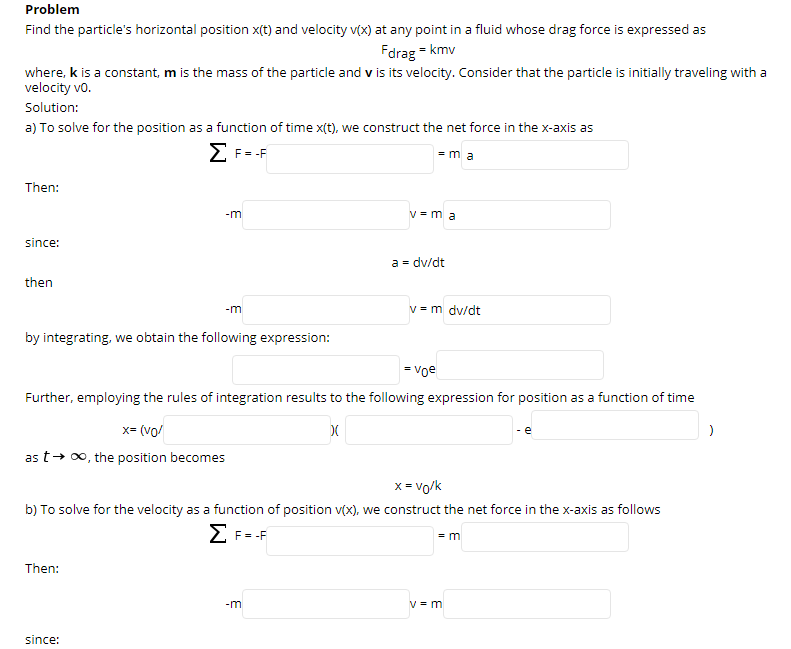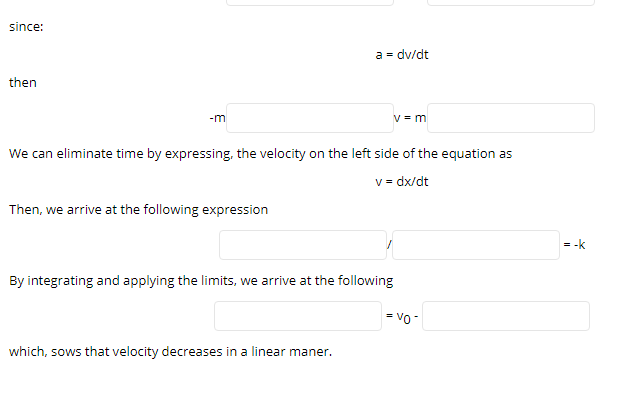Problem Find the particle's horizontal position x(t) and velocity v(x) at any point in a fluid whose drag force is expressed as Fdrag = kmv where, k is a constant, m is the mass of the particle and v is its velocity. Consider that the particle is initially traveling with a velocity vo. Solution: a) To solve for the position as a function of time x(t), we construct the net force in the x-axis as E F--F -m a Then: -m V=m a since: a = dv/dt then -m v=m dv/dt by integrating, we obtain the following expression: = voe Further, employing the rules of integration results to the following expression for position as a function of time x= (vo/ as t→ ∞, the position becomes x = vo/k b) To solve for the velocity as a function of position v(x), we construct the net force in the x-axis as follows E F--F Then: -m V = m
Problem Find the particle's horizontal position x(t) and velocity v(x) at any point in a fluid whose drag force is expressed as Fdrag = kmv where, k is a constant, m is the mass of the particle and v is its velocity. Consider that the particle is initially traveling with a velocity vo. Solution: a) To solve for the position as a function of time x(t), we construct the net force in the x-axis as E F--F -m a Then: -m V=m a since: a = dv/dt then -m v=m dv/dt by integrating, we obtain the following expression: = voe Further, employing the rules of integration results to the following expression for position as a function of time x= (vo/ as t→ ∞, the position becomes x = vo/k b) To solve for the velocity as a function of position v(x), we construct the net force in the x-axis as follows E F--F Then: -m V = m
Physics for Scientists and Engineers: Foundations and Connections
1st Edition
ISBN:9781133939146
Author:Katz, Debora M.
Publisher:Katz, Debora M.
Chapter6: Applications Of Newton’s Laws Of Motion
Section: Chapter Questions
Problem 62PQ
Related questions
Question

Transcribed Image Text:Problem
Find the particle's horizontal position x(t) and velocity v(x) at any point in a fluid whose drag force is expressed as
Fdrag = kmv
where, k is a constant, m is the mass of the particle and v is its velocity. Consider that the particle is initially traveling with a
velocity vo.
Solution:
a) To solve for the position as a function of time x(t), we construct the net force in the x-axis as
E F--F
= m a
Then:
-m
V = m a
since:
a = dv/dt
then
v = m dv/dt
-m
by integrating, we obtain the following expression:
= voe
Further, employing the rules of integration results to the following expression for position as a function of time
x= (vo/
- e
as t+ 0, the position becomes
x = vo/k
b) To solve for the velocity as a function of position v(x), we construct the net force in the x-axis as follows
E F--F
= m
Then:
-m
V = m
since:

Transcribed Image Text:since:
a = dv/dt
then
-m
V = m
We can eliminate time by expressing, the velocity on the left side of the equation as
v = dx/dt
Then, we arrive at the following expression
= -k
By integrating and applying the limits, we arrive at the following
= vo-
which, sows that velocity decreases in a linear maner.
Expert Solution
This question has been solved!
Explore an expertly crafted, step-by-step solution for a thorough understanding of key concepts.
Step by step
Solved in 2 steps

Knowledge Booster
Learn more about
Need a deep-dive on the concept behind this application? Look no further. Learn more about this topic, physics and related others by exploring similar questions and additional content below.Recommended textbooks for you

Physics for Scientists and Engineers: Foundations…
Physics
ISBN:
9781133939146
Author:
Katz, Debora M.
Publisher:
Cengage Learning

Principles of Physics: A Calculus-Based Text
Physics
ISBN:
9781133104261
Author:
Raymond A. Serway, John W. Jewett
Publisher:
Cengage Learning

College Physics
Physics
ISBN:
9781938168000
Author:
Paul Peter Urone, Roger Hinrichs
Publisher:
OpenStax College

Physics for Scientists and Engineers: Foundations…
Physics
ISBN:
9781133939146
Author:
Katz, Debora M.
Publisher:
Cengage Learning

Principles of Physics: A Calculus-Based Text
Physics
ISBN:
9781133104261
Author:
Raymond A. Serway, John W. Jewett
Publisher:
Cengage Learning

College Physics
Physics
ISBN:
9781938168000
Author:
Paul Peter Urone, Roger Hinrichs
Publisher:
OpenStax College